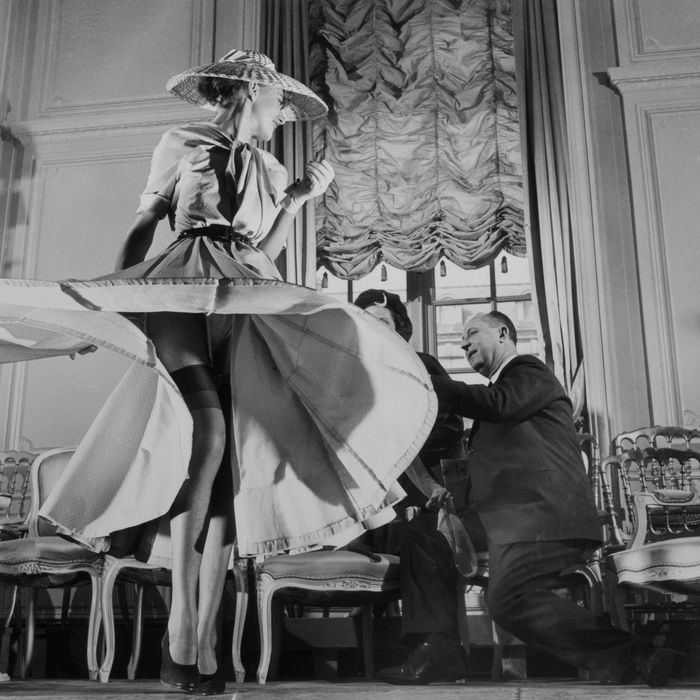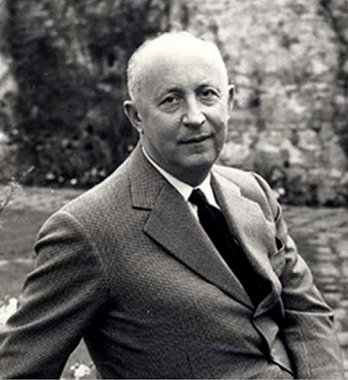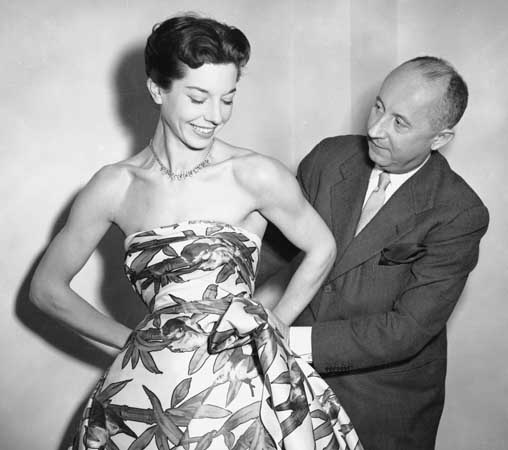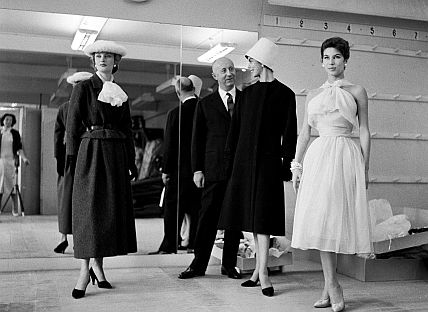Fashion Flashback: Christian Dior
This week I’m starting a new addition to my Fashion Flashback segment – I’ll be featuring a famous fashion designer every other week whose designs have revolutionized the fashion industry. Though we know the names of many of the great designs – Dior, Prada, Gucci, Vuitton – we often overlook their own personal stories. I’ll be starting off the series with famed French designer, [shopsense shopsense_url=”none” original_url=”http://www.dior.com/home/en_us?gclid=CKrR6N2sh7gCFcN_QgodOUkASQ&dior=&ved=0CDQQ0Qw&adurl=httpwwwdiorcomhomeen_us=” save_to_store=”true”]Christian Dior[/shopsense].

Christian Dior was born on January 21, 1905, near Normandy, France, the second child of five, to Maurice Dior and Isabelle Cardamone. Always showing an affinity and passion for the arts, Dior aspired to be an architect but his family had different dreams for him – to become a diplomat. In 1925 Dior enrolled at École des Sciences Politiques to study political science. Following his graduation, Dior opened a small art gallery with an investment from his father under the agreement that the Dior name would appear above the gallery door. During the three years the gallery was open, art work from many famous artists passed through the doors including that of Pablo Picasso and Georges Braque. Dior was forced to close the gallery in 1931 when his father fell on hard times financially and both his mother and brother passed away.
Throughout the subsequent years, Dior sold fashion sketches and eventually landed a job illustrating a French magazine however, with the onset of World War II Dior was called to serve in the French army. When France surrendered to Germany in 1940, Dior left the army, returned to Paris and worked in the fashion house of Lucien Lelong, where he would remain for the duration of the war. During this time Dior designed dresses for the wives of Nazi officers, while his sister, a member of the French Resistance, was captured by the Gestapo and sent to Ravensbrück Concentration Camp (she was released in 1945).
What we know today as the Dior Fashion House, began on December 16, 1946, funded by Marcel Boussac. Dior’s first collection (“Corolle”) launched in 1947 and, as coined by Harper’s Bazaar Editor-in-Chief Carmel Snow, became known as the “New Look”. Unlike the boxy wartime designs, the post-war New Look focused on femininity and featured voluptuous silhouettes, full skirts and hems that flattered women’s calves. Dior’s New Look revolutionized women’s fashion and brought Paris back as the center of fashion.
Sadly, Dior passed away unexpectedly on October 23, 1957. Dior’s funeral was attended by an estimated 2,500 people, including all of his staff and many of his most famous clients. He was buried in Cimetière de Callian, in Var, France. At the time of his death, Dior’s house was earning more than $20 million annually. Dior has forever left is mark on fashion and style.













Really informative ! I love Dior ! (:
xoxo
couturecrush.net
Great thanks
شركة تنظيف منازل بالرياض شركة تنظيف بيوت بالرياض شركة تنظيف خزانات بالرياض شركة غسيل خزانات بالرياض شركة تنظيف واجهات حجر بالرياض شركة عزل خزانات بالرياض شركة تسليك مجارى بالرياض شركة تنظيف بيارات بالرياض شركة نقل اثاث بالرياض شركة نقل عفش بالرياض شركة تخزين اثاث بالرياض مستودعات تخزين اثاث بالرياض شركة تخزين عفش بالرياض شركة مكافحة حشرات بالرياض شركة مكافحة حشرات شركة رش مبيدات بالرياض شركة مكافحة النمل الأبيض بالرياض شركة مكافحة العثة بالرياض شركة تنظيف مسابح بالرياض شركة تنظيف فلل بالرياض شركة نظافة فلل بالرياض شركة تنظيف شقق بالرياض شركة نظافة بالرياض شركة تنظيف مساجد بالرياض شركة كشف تسربات المياه بالرياض كشف تسربات المياه شركة تنظيف واجهات زجاج بالرياض شركة تنظيف مجالس بالرياض شركة غسيل مجالس بالرياض
thnaks
What an icon!
Great write up
Great thanks
شركة تنظيف منازل بالرياض شركة تنظيف بيوت بالرياض شركة تنظيف خزانات بالرياض شركة غسيل خزانات بالرياض شركة تنظيف واجهات حجر بالرياض شركة عزل خزانات بالرياض شركة تسليك مجارى بالرياض شركة تنظيف بيارات بالرياض شركة نقل اثاث بالرياض شركة نقل عفش بالرياض شركة تخزين اثاث بالرياض مستودعات تخزين اثاث بالرياض شركة تخزين عفش بالرياض شركة مكافحة حشرات بالرياض شركة مكافحة حشرات شركة رش مبيدات بالرياض شركة مكافحة النمل الأبيض بالرياض شركة مكافحة العثة بالرياض شركة تنظيف مسابح بالرياض شركة تنظيف فلل بالرياض شركة نظافة فلل بالرياض شركة تنظيف شقق بالرياض شركة نظافة بالرياض شركة تنظيف مساجد بالرياض شركة كشف تسربات المياه بالرياض كشف تسربات المياه شركة تنظيف واجهات زجاج بالرياض شركة تنظيف مجالس بالرياض شركة غسيل مجالس بالرياض
thnaks
شركة تنظيف خزانات بالرياض
شركة تنظيف مسابح بالرياض
شركة تنظيف بيارات بالرياض
شركة تسليك مجاري بالرياض
شركة تنظيف منازل بالرياض
شركة تنظيف فلل بالرياض
شركة تنظيف شقق بالرياض
شركة مكافحة حشرات بالرياض
شركة مكافحة البق بالرياض
شركة مكافحة فئران بالرياض
شركة رش مبيدات بالرياض
شركة نقل اثاث بالرياض
شركة نقل عفش بالرياض
شركة تخزين اثاث بالرياض
شركة تخزين عفش بالرياض
شركة كشف تسربات المياه بالرياض
شركة كشف تسربات بالرياض
Great write up
شركة
نقل اثاث بالرياض
شركة
تنظيف مجالس بالرياض
شركة
تنظيف موكيت بالرياض
شركة
كشف تسربات بالرياض
شركة
تسليك مجارى بالرياض
شركة
تنظيف بيارات بالرياض
شركة
تنظيف مسابح بالرياض
شركة
تنظيف مجالس بالرياض
شركة
غسيل خزانات بالرياض
شركة
تخزين اثاث بالرياض
شركة
تنظيف منازل بالرياض
شركة
نقل اثاث بالرياض
شركة
عزل خزانات بالرياض
شركة
تنظيف كنب بالرياض
شركة
مكافحة حشرات بالرياض
شركة
تنظيف اثاث بالرياض
شركة
رش مبيدات بالرياض
شركة
عزل خزانات بالرياض
شركة
عزل حراري
شركة
عزل مائي
شركة
تنظيف مجالس بالرياض
شركة
تنظيف شقق بالرياض
شركة
كشف تسربات المياه بالرياض
شركة
تنظيف فلل بالدمام
شركة
تنظيف بالدمام
مكافحة
الحشرات ورش المبيدات
شركة
كشف تسربات بجده
شركة
كشف تسربات بالخرج
شركة تنظيف فلل
بالدمام
شركات نقل عفش بالدمام
شركة
مكافحة حشرات بالخبر
شركة
عزل اسطح بالخرج
شركة
تنظيف بيارات بالرياض
اثاث
مستعمل
here
here
here
here
here
Very good post …….. thanks
https://b-yout.com/%D9%86%D9%82%D9%84-%D8%A7%D8%AB%D8%A7%D8%AB-%D9%86%D9%82%D9%84-%D8%B9%D9%81%D8%B4/
https://b-yout.com/%D8%B4%D8%B1%D9%83%D8%A9-%D9%83%D8%B4%D9%81-%D8%AA%D8%B3%D8%B1%D8%A8%D8%A7%D8%AA-%D8%A7%D9%84%D9%85%D9%8A%D8%A7%D9%87-%D8%A8%D8%A7%D9%84%D8%B1%D9%8A%D8%A7%D8%B6/
https://b-yout.com/%D8%A7%D9%81%D8%B6%D9%84-%D8%B4%D8%B1%D9%83%D8%A9-%D8%AA%D8%AE%D8%B2%D9%8A%D9%86-%D8%A7%D8%AB%D8%A7%D8%AB-%D8%A8%D8%A7%D9%84%D8%B1%D9%8A%D8%A7%D8%B6/
https://b-yout.com/%D8%B4%D8%B1%D9%83%D8%A9-%D8%AA%D8%B1%D9%85%D9%8A%D9%85-%D8%A7%D9%84%D9%85%D9%86%D8%A7%D8%B2%D9%84-%D8%A8%D8%A7%D9%84%D8%B1%D9%8A%D8%A7%D8%B6/
https://b-yout.com/%D8%B4%D8%B1%D9%83%D8%A9-%D8%B1%D8%B4-%D9%85%D8%A8%D9%8A%D8%AF%D8%A7%D8%AA-%D9%88%D9%85%D9%83%D8%A7%D9%81%D8%AD%D8%A9-%D8%A7%D9%84%D8%AD%D8%B4%D8%B1%D8%A7%D8%AA/
https://b-yout.com/%D8%B4%D8%B1%D9%83%D8%A9-%D8%AA%D9%86%D8%B8%D9%8A%D9%81-%D9%85%D9%86%D8%A7%D8%B2%D9%84-%D8%A8%D8%A7%D9%84%D8%B1%D9%8A%D8%A7%D8%B6/
https://b-yout.com/%D8%B4%D8%B1%D9%83%D8%A9-%D9%83%D8%B4%D9%81-%D8%AA%D8%B3%D8%B1%D8%A8%D8%A7%D8%AA-%D8%A7%D9%84%D9%85%D9%8A%D8%A7%D9%87-%D8%A8%D8%A7%D9%84%D8%B1%D9%8A%D8%A7%D8%B6/
https://b-yout.com/%D8%A7%D9%81%D8%B6%D9%84-%D8%B4%D8%B1%D9%83%D8%A9-%D8%AA%D8%AE%D8%B2%D9%8A%D9%86-%D8%A7%D8%AB%D8%A7%D8%AB-%D8%A8%D8%A7%D9%84%D8%B1%D9%8A%D8%A7%D8%B6/
https://b-yout.com/%D8%B4%D8%B1%D9%83%D8%A9-%D8%B1%D8%B4-%D9%85%D8%A8%D9%8A%D8%AF%D8%A7%D8%AA-%D9%88%D9%85%D9%83%D8%A7%D9%81%D8%AD%D8%A9-%D8%A7%D9%84%D8%AD%D8%B4%D8%B1%D8%A7%D8%AA/
https://b-yout.com/%D8%B4%D8%B1%D9%83%D8%A9-%D8%AA%D8%B1%D9%85%D9%8A%D9%85-%D8%A7%D9%84%D9%85%D9%86%D8%A7%D8%B2%D9%84-%D8%A8%D8%A7%D9%84%D8%B1%D9%8A%D8%A7%D8%B6/
http://middleast-sa.com/%D9%83%D8%B4%D9%81-%D8%AA%D8%B3%D8%B1%D8%A8%D8%A7%D8%AA/
http://middleast-sa.com/%D8%A7%D9%84%D8%B9%D8%B2%D9%84-%D8%A7%D9%84%D9%85%D8%A7%D8%A6%D9%8A/
http://middleast-sa.com/%D8%B1%D8%B4-%D9%85%D8%A8%D9%8A%D8%AF%D8%A7%D8%AA/
http://middleast-sa.com/%D8%B1%D8%B4-%D9%85%D8%A8%D9%8A%D8%AF%D8%A7%D8%AA/
http://middleast-sa.com/%D9%86%D9%82%D9%84-%D8%A3%D8%AB%D8%A7%D8%AB/
http://middleast-sa.com/%D9%86%D9%82%D9%84-%D8%A3%D8%AB%D8%A7%D8%AB/
http://middleast-sa.com/%D8%AA%D9%86%D8%B8%D9%8A%D9%81-%D8%A7%D9%84%D9%85%D9%86%D8%A7%D8%B2%D9%84/
http://middleast-sa.com/%D8%AA%D8%B1%D9%85%D9%8A%D9%85-%D8%A7%D9%84%D9%85%D9%86%D8%A7%D8%B2%D9%84/
http://middleast-sa.com/%D8%AA%D8%B1%D9%85%D9%8A%D9%85-%D8%A7%D9%84%D9%85%D9%86%D8%A7%D8%B2%D9%84/
http://middleast-sa.com/%D9%83%D8%B4%D9%81-%D8%AA%D8%B3%D8%B1%D8%A8%D8%A7%D8%AA/
[URL=”http://www.companysaudiarabia.com/menu.php”]افضل شركة كشف تسربات المياه بالرياض[/URL]
[URL=”http://arabianislandco.com/%D8%B9%D8%B2%D9%84-%D9%85%D8%A7%D8%A6%D9%8A.php”]افضل شركة عزل مائي بالرياض[/URL]
[URL=”http://waters-isolate-leaks.com/%D8%B9%D8%B2%D9%84-%D9%85%D8%A7%D8%A6%D9%89.php”]افضل شركة عزل خزانات بالرياض[/URL]
[URL=”http://www.companysaudiarabia.com/%D9%85%D9%83%D8%A7%D9%81%D8%AD%D8%A9-%D8%A7%D9%84%D8%AD%D8%B4%D8%B1%D8%A7%D8%AA.php”]افضل شركه مكافحة حشرات بالرياض[/URL]
[URL=”http://arabianislandco.com/”]اصلاح حمامات ومطابخ بالرياض[/URL]
[URL=”http://waters-isolate-leaks.com/%D8%B9%D8%B2%D9%84-%D9%85%D8%A7%D8%A6%D9%89.php”]افضل شركة عزل حمامات وخزانات[/URL]
[URL=”http://www.companysaudiarabia.com/”]عزل مائي وحرارى للاسطح[/URL]
[URL=”http://www.companysaudiarabia.com/menu.php”]كشف تسربات المياه بالمنزل[/URL]
[URL=”http://arabianislandco.com/%D8%B9%D8%B2%D9%84-%D9%85%D8%A7%D8%A6%D9%8A.php”]شركه عزل مائي وحرارى بالرياض[/URL]
[URL=”http://waters-isolate-leaks.com/%D8%B9%D8%B2%D9%84-%D9%85%D8%A7%D8%A6%D9%89.php”]شركه غسيل خزانات مع التعقيم[/URL]
.
Houses cleaning company revealed water leaks we now we now rely on the highest quality global and international detergents registered in domestic services شركة تنظيف بخميس مشيط We also have after other services, including wiring, sewage services تسليك مجارى بخميس مشيط
And services related to this field also detect water leaks Services شركة كشف تسربات بخميس مشيط It is also useful services and required a home pest control services مكافحة حشرات بخميس مشيط مكافحة حشرات بابها It is our company services Kheir, a roofing and thermal insulation of roofs by methods scientifically certain services and not harmful to the surface of the house شركة عزل اسطح بخميس مشيط عزل اسطح بابها And we have other services such as home furnishings and storage transport services and transport to anywhere in the Kingdom نقل اثاث بخميس مشيط
Very good post …….. thanks
[CENTER][SIZE=3][SIZE=5][URL=”http://elawaeil.com/%D8%B4%D8%B1%D9%83%D8%A9-%D9%86%D9%82%D9%84-%D8%A3%D8%AB%D8%A7%D8%AB-%D8%A8%D8%A7%D9%84%D8%B1%D9%8A%D8%A7%D8%B6-%D8%B9%D9%85%D8%A7%D9%84%D8%A9-%D9%81%D9%84%D8%A8%D9%8A%D9%86%D9%8A%D8%A9/”][B]شركة نقل عفش بالرياض [/B]
[/URL][/SIZE]هل ترددت كثيرا أثناء الانتقال من مكان لأخر أو من مدينة لأخرى ؟
هل السبب الرئيسي لخوفك من الانتقال ما سيصاحب هذا الانتقال من فك للأثاث و تغليفه و نقله و تخزينه وإعادة تركيبه مرة أخرى وكل ذلك دون أن يحدث له أى خدش أو ضرر ؟
هل لا تخشى وتتردد فى استخدام [URL=”http://elawaeil.com/%D8%B4%D8%B1%D9%83%D8%A9-%D9%86%D9%82%D9%84-%D8%A3%D8%AB%D8%A7%D8%AB-%D8%A8%D8%A7%D9%84%D8%B1%D9%8A%D8%A7%D8%B6-%D8%B9%D9%85%D8%A7%D9%84%D8%A9-%D9%81%D9%84%D8%A8%D9%8A%D9%86%D9%8A%D8%A9/”]شركات نقل العفش بالرياض[/URL] بسبب عدم الثقة فيهم أو أن يكون العاملين لديهم ليسوا على مستوى عالى من الكفاءة والحرفية والأمانة ؟
هل تخشى من إضاعة المجهود والوقت فى نقل الأثاث وفكه وإعادة تركيبه ونقله وتغليفه ؟
هل تتساءل عن كيفية[URL=”http://elawaeil.com/%D8%B4%D8%B1%D9%83%D8%A9-%D9%86%D9%82%D9%84-%D8%A3%D8%AB%D8%A7%D8%AB-%D8%A8%D8%A7%D9%84%D8%B1%D9%8A%D8%A7%D8%B6-%D8%B9%D9%85%D8%A7%D9%84%D8%A9-%D9%81%D9%84%D8%A8%D9%8A%D9%86%D9%8A%D8%A9/”] نقل العفش بالرياض[/URL] من الأماكن ذات السلالم الضيقة والأسانسيرات الضيقة المساحات ؟
هل تتساءل عن كيفية إنزال العفش من الأدوار المرتفعة دون جهد أو تلف ؟
هل لا تملك من الأيدي العاملة معك ما يناسب كمية الأثاث لإنجاز العمل بأسرع وقت وجهد ؟ هل تخشى من التعرض للاستغلال من [URL=”http://elawaeil.com/%D8%B4%D8%B1%D9%83%D8%A9-%D9%86%D9%82%D9%84-%D8%A3%D8%AB%D8%A7%D8%AB-%D8%A8%D8%A7%D9%84%D8%B1%D9%8A%D8%A7%D8%B6-%D8%B9%D9%85%D8%A7%D9%84%D8%A9-%D9%81%D9%84%D8%A8%D9%8A%D9%86%D9%8A%D8%A9/”]شركات نقل الأثاث بالرياض[/URL] من حيث الأسعار ؟
[/SIZE]
[SIZE=3][IMG]http://elawaeil.com/wp-content/uploads/2016/05/%D8%B4%D8%B1%D9%83%D8%A9-%D9%86%D9%82%D9%84-%D8%A7%D8%AB%D8%A7%D8%AB-%D8%A8%D8%A7%D9%84%D8%B1%D9%8A%D8%A7%D8%B6-%D8%B9%D9%85%D8%A7%D9%84%D8%A9-%D9%81%D9%84%D8%A8%D9%8A%D9%86%D9%8A%D8%A9.png[/IMG][/SIZE]
[SIZE=3]تساؤلات كثيرة تجعل من الصعب الانتقال من مكان لأخر وتجعل عملية نقل الأثاث مكلفة ومرهقة و تتسبب فى الكثير من التلف لمحتويات العفش والأثاث ، وأيضا قلقنا الدائم من تضرر الأثاث أو تكسره أو إهدار الكثير من الوقت والمجهود والأموال دون جدوى .
ولأجل كافة تساؤلاتكم عملاؤنا الكرام فنحن شركتكم [URL=”http://elawaeil.com/%D8%B4%D8%B1%D9%83%D8%A9-%D9%86%D9%82%D9%84-%D8%A3%D8%AB%D8%A7%D8%AB-%D8%A8%D8%A7%D9%84%D8%B1%D9%8A%D8%A7%D8%B6-%D8%B9%D9%85%D8%A7%D9%84%D8%A9-%D9%81%D9%84%D8%A8%D9%8A%D9%86%D9%8A%D8%A9/”] شركة نقل أثاث بالرياض[/URL] من أفضل الشركات و أكفئها و أعلاها دقة وأمانة فى نقل وفك وتركيب و إعادة تركيب وتخزين العفش بكل حرفية ودقة ومع الاهتمام بكل محتويات العفش سواء ثمينة أو حساسة أو صغيرة الحجم .
المصدر| [URL]http://elawaeil.com/%D8%B4%D8%B1%D9%83%D8%A9-%D9%86%D9%82%D9%84-%D8%A3%D8%AB%D8%A7%D8%AB-%D8%A8%D8%A7%D9%84%D8%B1%D9%8A%D8%A7%D8%B6-%D8%B9%D9%85%D8%A7%D9%84%D8%A9-%D9%81%D9%84%D8%A8%D9%8A%D9%86%D9%8A%D8%A9/[/URL]
لمزيدمن خدماتنا
[URL=”http://elawaeil.com/%D8%B4%D8%B1%D9%83%D8%A9-%D8%AA%D9%86%D8%B8%D9%8A%D9%81-%D9%85%D9%86%D8%A7%D8%B2%D9%84-%D8%A8%D8%A7%D9%84%D8%B1%D9%8A%D8%A7%D8%B6-2/”]شركة تنظيف منازل بالرياض[/URL][/SIZE][/CENTER]
Go Trainings
Ab initio Training
Android App Development
Adminstudio
Microsoft App v Training
Dellboomi
Hadoop Tutorial
Oracle My SQL Training
Oracle 11g DBA Training
Sap Programming Lanuage (Abap)
Oracle SOA Certification
Windows Powershell
Sap BW Hana Online Training Institute
Free Sap Training & Placement
Sap Fiori Course Offered
Sap SD Training Online
Microsoft SCCM 2016 Training
Selenium Tutorial For Beginners
SQL Server DBA Training & Placement
Tableau Carrers
Testing Tools Software Tools
شركتنا هي الشركة الأفضل في توفير أفضل الخدمات المنزلية في المملكة العربية السعودية هي شركة تقدم أرخص الأسعار فإذا كنت في مدنية ابها وتريد شركة تلبي كافة الخدمات المنزلية عليكم بالتواصل معنا عبر خدماتنا التالية شركة تنظيف بابها شركة تنظيف خزانات بابها شركة تنظيف منازل بابها شركة تنظيف موكيت بابها شركة نقل اثاث بابها
الجميع يعلم مدى الأهمية القصوى في توفير شركة تنظيف منازل بنجران ويجيب أن يتوفر ايضا مياه نظيفة خالية من الأوساخ والشوائب لكي تضمني حياة صحية سعيدة تنظيف خزانات بنجرانكما ايضا فروع شركتنا مستمرة في مدينة بيشة في المنطقة الجنوبية في المملكة العربية السعودية شركة تنظيف ببيشة كما نقدم خدمة للقضاء على كافة أنواع الحشرات في أسرع وقت ممكن مع الضمان شركة مكافحة حشرات بمحايل عسير
Al-Kharj Group Company is the best company in providing all solutions in Riyadh city. Solutions for Al-Kharj Municipality. The company has the best team that specializes in all household services from surface insulation, insulation of tanks, insect control, pesticides, pest control services. as soon as possibleشركة نقل عفش بالخرج شركة تنظيف بيارات بالخرج
شركة تسليك مجاري بالخرجشركة عزل اسطح بالخرج شركة صيانة كهرباء بالخرج
شركة كشف تسربات المياه بالخرجشركة رش مبيدات بالخرج شركة عزل خزانات بالخرج
Love the classic images